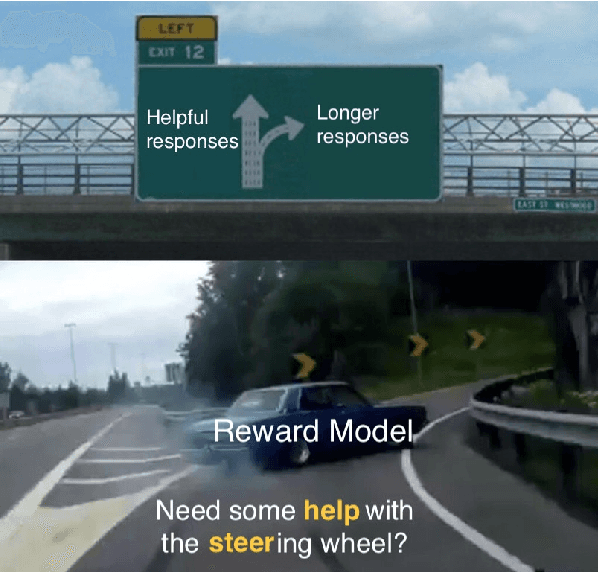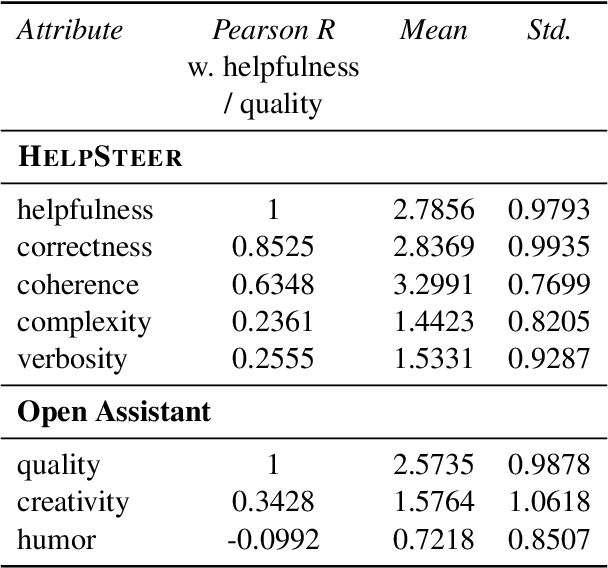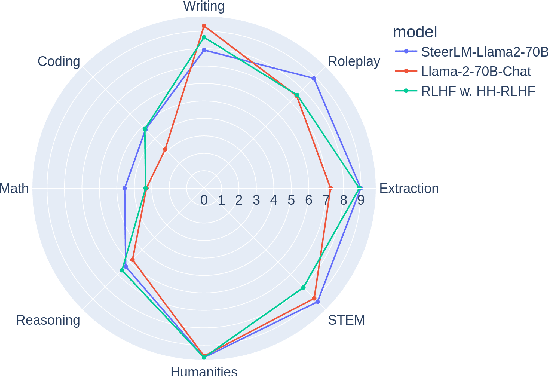Makesh Narsimhan Sreedhar
Nemotron-H: A Family of Accurate and Efficient Hybrid Mamba-Transformer Models
Apr 10, 2025Abstract:As inference-time scaling becomes critical for enhanced reasoning capabilities, it is increasingly becoming important to build models that are efficient to infer. We introduce Nemotron-H, a family of 8B and 56B/47B hybrid Mamba-Transformer models designed to reduce inference cost for a given accuracy level. To achieve this goal, we replace the majority of self-attention layers in the common Transformer model architecture with Mamba layers that perform constant computation and require constant memory per generated token. We show that Nemotron-H models offer either better or on-par accuracy compared to other similarly-sized state-of-the-art open-sourced Transformer models (e.g., Qwen-2.5-7B/72B and Llama-3.1-8B/70B), while being up to 3$\times$ faster at inference. To further increase inference speed and reduce the memory required at inference time, we created Nemotron-H-47B-Base from the 56B model using a new compression via pruning and distillation technique called MiniPuzzle. Nemotron-H-47B-Base achieves similar accuracy to the 56B model, but is 20% faster to infer. In addition, we introduce an FP8-based training recipe and show that it can achieve on par results with BF16-based training. This recipe is used to train the 56B model. All Nemotron-H models will be released, with support in Hugging Face, NeMo, and Megatron-LM.
Aegis2.0: A Diverse AI Safety Dataset and Risks Taxonomy for Alignment of LLM Guardrails
Jan 15, 2025



Abstract:As Large Language Models (LLMs) and generative AI become increasingly widespread, concerns about content safety have grown in parallel. Currently, there is a clear lack of high-quality, human-annotated datasets that address the full spectrum of LLM-related safety risks and are usable for commercial applications. To bridge this gap, we propose a comprehensive and adaptable taxonomy for categorizing safety risks, structured into 12 top-level hazard categories with an extension to 9 fine-grained subcategories. This taxonomy is designed to meet the diverse requirements of downstream users, offering more granular and flexible tools for managing various risk types. Using a hybrid data generation pipeline that combines human annotations with a multi-LLM "jury" system to assess the safety of responses, we obtain Aegis 2.0, a carefully curated collection of 34,248 samples of human-LLM interactions, annotated according to our proposed taxonomy. To validate its effectiveness, we demonstrate that several lightweight models, trained using parameter-efficient techniques on Aegis 2.0, achieve performance competitive with leading safety models fully fine-tuned on much larger, non-commercial datasets. In addition, we introduce a novel training blend that combines safety with topic following data.This approach enhances the adaptability of guard models, enabling them to generalize to new risk categories defined during inference. We plan to open-source Aegis 2.0 data and models to the research community to aid in the safety guardrailing of LLMs.
Unsupervised Extraction of Dialogue Policies from Conversations
Jun 21, 2024Abstract:Dialogue policies play a crucial role in developing task-oriented dialogue systems, yet their development and maintenance are challenging and typically require substantial effort from experts in dialogue modeling. While in many situations, large amounts of conversational data are available for the task at hand, people lack an effective solution able to extract dialogue policies from this data. In this paper, we address this gap by first illustrating how Large Language Models (LLMs) can be instrumental in extracting dialogue policies from datasets, through the conversion of conversations into a unified intermediate representation consisting of canonical forms. We then propose a novel method for generating dialogue policies utilizing a controllable and interpretable graph-based methodology. By combining canonical forms across conversations into a flow network, we find that running graph traversal algorithms helps in extracting dialogue flows. These flows are a better representation of the underlying interactions than flows extracted by prompting LLMs. Our technique focuses on giving conversation designers greater control, offering a productivity tool to improve the process of developing dialogue policies.
Nemotron-4 340B Technical Report
Jun 17, 2024



Abstract:We release the Nemotron-4 340B model family, including Nemotron-4-340B-Base, Nemotron-4-340B-Instruct, and Nemotron-4-340B-Reward. Our models are open access under the NVIDIA Open Model License Agreement, a permissive model license that allows distribution, modification, and use of the models and its outputs. These models perform competitively to open access models on a wide range of evaluation benchmarks, and were sized to fit on a single DGX H100 with 8 GPUs when deployed in FP8 precision. We believe that the community can benefit from these models in various research studies and commercial applications, especially for generating synthetic data to train smaller language models. Notably, over 98% of data used in our model alignment process is synthetically generated, showcasing the effectiveness of these models in generating synthetic data. To further support open research and facilitate model development, we are also open-sourcing the synthetic data generation pipeline used in our model alignment process.
HelpSteer2: Open-source dataset for training top-performing reward models
Jun 12, 2024Abstract:High-quality preference datasets are essential for training reward models that can effectively guide large language models (LLMs) in generating high-quality responses aligned with human preferences. As LLMs become stronger and better aligned, permissively licensed preference datasets, such as Open Assistant, HH-RLHF, and HelpSteer need to be updated to remain effective for reward modeling. Methods that distil preference data from proprietary LLMs such as GPT-4 have restrictions on commercial usage imposed by model providers. To improve upon both generated responses and attribute labeling quality, we release HelpSteer2, a permissively licensed preference dataset (CC-BY-4.0). Using a powerful internal base model trained on HelpSteer2, we are able to achieve the SOTA score (92.0%) on Reward-Bench's primary dataset, outperforming currently listed open and proprietary models, as of June 12th, 2024. Notably, HelpSteer2 consists of only ten thousand response pairs, an order of magnitude fewer than existing preference datasets (e.g., HH-RLHF), which makes it highly efficient for training reward models. Our extensive experiments demonstrate that reward models trained with HelpSteer2 are effective in aligning LLMs. In particular, we propose SteerLM 2.0, a model alignment approach that can effectively make use of the rich multi-attribute score predicted by our reward models. HelpSteer2 is available at https://huggingface.co/datasets/nvidia/HelpSteer2 and code is available at https://github.com/NVIDIA/NeMo-Aligner
CantTalkAboutThis: Aligning Language Models to Stay on Topic in Dialogues
Apr 04, 2024Abstract:Recent advancements in instruction-tuning datasets have predominantly focused on specific tasks like mathematical or logical reasoning. There has been a notable gap in data designed for aligning language models to maintain topic relevance in conversations - a critical aspect for deploying chatbots to production. We introduce the CantTalkAboutThis dataset to help language models remain focused on the subject at hand during task-oriented interactions. It consists of synthetic dialogues on a wide range of conversation topics from different domains. These dialogues are interspersed with distractor turns that intentionally divert the chatbot from the predefined topic. Fine-tuning language models on this dataset helps make them resilient to deviating from the role assigned and improves their ability to maintain topical coherence compared to general-purpose instruction-tuned LLMs like GPT-4-turbo and Mixtral-Instruct. Additionally, preliminary observations suggest that training models on this dataset also enhance their performance on fine-grained instruction following tasks.
HelpSteer: Multi-attribute Helpfulness Dataset for SteerLM
Nov 16, 2023



Abstract:Existing open-source helpfulness preference datasets do not specify what makes some responses more helpful and others less so. Models trained on these datasets can incidentally learn to model dataset artifacts (e.g. preferring longer but unhelpful responses only due to their length). To alleviate this problem, we collect HelpSteer, a multi-attribute helpfulness dataset annotated for the various aspects that make responses helpful. Specifically, our 37k-sample dataset has annotations for correctness, coherence, complexity, and verbosity in addition to overall helpfulness of responses. Training Llama 2 70B using the HelpSteer dataset with SteerLM technique produces a model that scores 7.54 on MT Bench, which is currently the highest score for open models that do not require training data from more powerful models (e.g. GPT4). We release this dataset with CC-BY-4.0 license at https://huggingface.co/datasets/nvidia/HelpSteer
Evolving Domain Adaptation of Pretrained Language Models for Text Classification
Nov 16, 2023Abstract:Adapting pre-trained language models (PLMs) for time-series text classification amidst evolving domain shifts (EDS) is critical for maintaining accuracy in applications like stance detection. This study benchmarks the effectiveness of evolving domain adaptation (EDA) strategies, notably self-training, domain-adversarial training, and domain-adaptive pretraining, with a focus on an incremental self-training method. Our analysis across various datasets reveals that this incremental method excels at adapting PLMs to EDS, outperforming traditional domain adaptation techniques. These findings highlight the importance of continually updating PLMs to ensure their effectiveness in real-world applications, paving the way for future research into PLM robustness against the natural temporal evolution of language.
SteerLM: Attribute Conditioned SFT as an (User-Steerable) Alternative to RLHF
Oct 09, 2023Abstract:Model alignment with human preferences is an essential step in making Large Language Models (LLMs) helpful and consistent with human values. It typically consists of supervised fine-tuning (SFT) and reinforcement learning from human feedback (RLHF) stages. However, RLHF faces inherent limitations stemming from a complex training setup and its tendency to align the model with implicit values that end users cannot control at run-time. Moreover, reward models in RLHF stage commonly rely on single-dimensional feedback as opposed to explicit, multifaceted signals that indicate attributes such as helpfulness, humor, and toxicity. To address these limitations, we propose SteerLM, a supervised fine-tuning method that empowers end-users to control responses during inference. SteerLM conditions responses to conform to an explicitly defined multi-dimensional set of attributes, thereby empowering a steerable AI capable of generating helpful and high-quality responses while maintaining customizability. Experiments show that SteerLM trained on open source datasets generates responses that are preferred by human and automatic evaluators to many state-of-the-art baselines trained with RLHF while being much easier to train. Try SteerLM at https://huggingface.co/nvidia/SteerLM-llama2-13B
Prompt Learning for Domain Adaptation in Task-Oriented Dialogue
Nov 10, 2022



Abstract:Conversation designers continue to face significant obstacles when creating production quality task-oriented dialogue systems. The complexity and cost involved in schema development and data collection is often a major barrier for such designers, limiting their ability to create natural, user-friendly experiences. We frame the classification of user intent as the generation of a canonical form, a lightweight semantic representation using natural language. We show that canonical forms offer a promising alternative to traditional methods for intent classification. By tuning soft prompts for a frozen large language model, we show that canonical forms generalize very well to new, unseen domains in a zero- or few-shot setting. The method is also sample-efficient, reducing the complexity and effort of developing new task-oriented dialogue domains.
 Add to Chrome
Add to Chrome Add to Firefox
Add to Firefox Add to Edge
Add to Edge